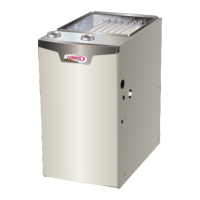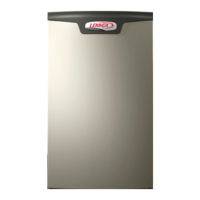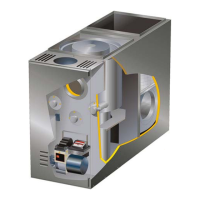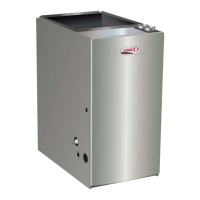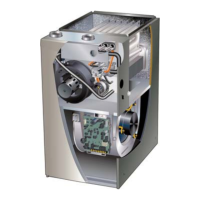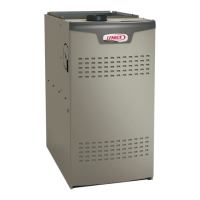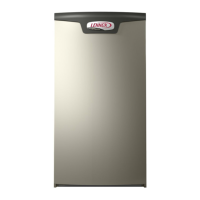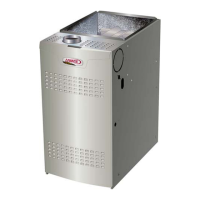Page 34
of the circuit being connected to one of the provided
neutral terminals. See FIGURE 55 for location of
terminal. This terminal is energized when the indoor
blower is operating.
8 - One line voltage “HUM” 1/4” spade terminal is
provided on the furnace integrated control. Any
humidier or other 120V accessory rated up to one
amp can be connected to this terminal with the
neutral leg of the circuit being connected to one of
the provided neutral terminals. See FIGURE 55 for
location of terminal. This terminal is energized in the
heating mode when the indoor blower is operating.
9 - One 24V “H” terminal is provided on the furnace
integrated control terminal block. Any humidier
rated up to 0.5 amp can be connected to this
terminal with the ground leg of the circuit being
connected to either ground or the “C” terminal. See
FIGURE 55 for location of terminal.
10 - 1 Install the room thermostat according to the
instructions provided with the thermostat. See
TABLE 15 for thermostat connections. If the
furnace is being matched with a heat pump, refer
to the instruction packaged with the dual fuel
thermostat.
NOTE - The discharge air temperature sensor is intended
to be mounted downstream of the heat exchanger and air
conditioning coil. It must be placed in free airow, where
other accessories (humidiers, UV lights etc.) will not in-
terfere with its accuracy. Wiring distance between the fur-
nace and discharge air sensor should not exceed 10 ft.
when wired with 18-gauge thermostat wire.
TABLE 13
Run Length - Non Communicating
Wire Run Length AWG# Insulation / Core Types
Less thsn 100’
(30m)
18
Color-coded, temperature
rating 95ºF (35ºC)
minimum, solid core.
(Class II 16 Rated
Wiring)
More than 100’
(30m)
16
TABLE 14
Run Length - Non Communicating
Wire Run Length AWG# Insulation / Core Types
Maximum length
of wiring for all
connections on the
RSBus is limited
to 1500 feet (457
meters).
18
Color-coded, temperature
rating 95ºF (35ºC)
minimum, solid core.
(Class II 16 Rated
Wiring)
Thermostat Selection
The SLP99UHV is designed to operate in a variable rate
capacity mode using a two-stage thermostat. The SL-
P99UHV will automatically adjust ring rate based upon
thermostat cycle times.
A communicating thermostat must be used in communi-
cating applications. Refer to the instructions provided with
the thermostat for installation, set-up and operation.
For optimal performance in non-communicating applica-
tions, Lennox recommends use of a ComfortSense® 7500
high quality electronic digital thermostat or any other with
adjustable settings for 1st stage / 2nd stage on / o dier-
entials and adjustable stage timers.
Lennox recommends the following two-stage thermostat
set-up for optimal variable rate capacity mode: First heat
stage dierential set to 1/2 to 1 degree F; second heat
stage dierential set to 1/2 or 1 degree F; second heat
stage upstage timer disabled, or set to maximum (1 hr
minimum).
Indoor Blower Speeds
NOTE - When the SLP99UHV is used with a communicat-
ing thermostat, proper indoor blower speed selections are
made by the thermostat.
1 - When the thermostat is set to “FAN ON,” the indoor
blower will run continuously at a percentage of
the second- stage cooling speed when there is no
cooling or heating demand. The percentage is set
using DIP switches 6 and 7. See TABLE 25 on page
48 for allowable circulatuion speeds.
2 - When the SLP99UHV is running in the heating
mode, the integrated control will automatically
adjust the blower speed to match the furnace ring
rate. This speed can be adjusted up or down by
7.5% or 15% using DIP switches 14 through 16
for the low heat speed and 17 through 19 for the
high heat speed. See TABLE 24 on page 48 for
allowable heating speeds.
3 - When there is a cooling demand, the indoor blower
will run on the cooling speed designated by the
positions of DIP switches 8 through 11.
Generator Use - Voltage Requirements
The following requirements must be kept in mind when
specifying a generator for use with this equipment:
• The furnace requires 120 volts + 10% (Range: 108 volts
to 132 volts).
• The furnace operates at 60 Hz + 5% (Range: 57 Hz to
63 Hz).
• The furnace integrated control requires both polarity
and proper ground. Both polarity and proper grounding
should be checked before attempting to operate the fur-
nace on either permanent or temporary power.
• Generator should have a wave form distortion of less
than 5% THD (total harmonic distortion).

